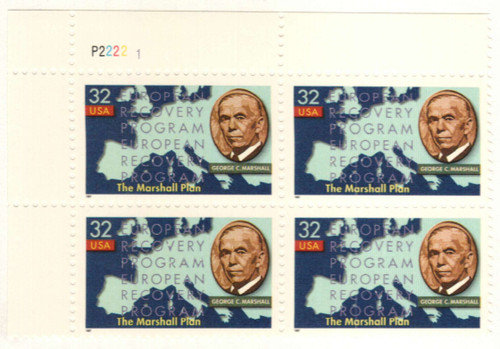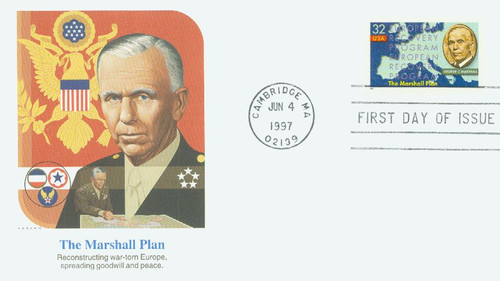
# 3141 - 1997 32c Marshall Plan
US #3141
1997 Marshall Plan
- Commemorates the 50th anniversary of the Marshall Plan
- Pictures a map of Europe, a portrait of George C. Marshall, and the words “European Recovery Program”
Stamp Category: Commemorative
Value: 32¢, First Class Mail Rate
First Day of Issue: June 4, 1997
First Day City: Cambridge, Massachusetts
Quantity Issued: 45,250,000
Printed by: Printed for Ashton Potter (USA) Ltd. By Stevens Varisize Security Documents
Printing Method: Offset, Intaglio
Format: Panes of 20 (Horizontal, 4 across, 5 down)
Perforations: 11.1
Tagging: Phosphored paper
Why the stamp was issued: To commemorate the 50th anniversary of the Marshall Plan, the legislation that helped Western Europe recover from the destruction and financial hardship left behind after World War II.
About the stamp design: Pictures a map of Europe with a drop shadow effect to make it appear “sunken.” A portrait of George C. Marshall was added at the right. It was based on Time magazine’s Man of the Year cover painting (by Ernest Hamlin Baker) from January 5, 1948. The words overlaying the map (repeated twice) read: “EUROPEAN RECOVERY PROGRAM.” The wording is the only part of the stamp design printed intaglio.
First Day City: The stamp was dedicated in a ceremony at the ARCO Forum of Public Affairs in the John F. Kennedy School of Government at Harvard University in Cambridge, Massachusetts. The stamp was released on the second day of a two-day international symposium called “Retrospect and Renewal: US-European Cooperation Fifty Years After the Marshall Plan.”
History the stamp represents: By the time World War II ended in 1945, much of Europe lay in ruins. Millions of refugees wandered through devastated battle areas. Disease and famine had spread rapidly. Confusion, disorder, and economic chaos had left many of these war-torn nations vulnerable to certain Communist take-over.
Realizing the political and economic stability of these nations was critical to future world peace. Secretary of State George C. Marshall outlined a four-year plan for economic assistance and recovery. The plan called for the US and other allied nations to strengthen Europe through a program of mutual aid assisted by grants from the US. Known as the Marshall Plan, it not only helped define this century and assured the peace we enjoy today, but its success also paved the way for additional foreign aid programs, such as NATO. Today, nearly every country has received US aid at one time or another.
Chief of Staff of the Army during World War II, Marshall played a vital role in the Allied victory. He later went on to serve as Secretary of State (1947-49) and Secretary of Defense (1950-51). In 1953, Marshall was awarded the Nobel Peace Prize for his role in developing the Marshall Plan. He is the only professional soldier to have received this distinguished award.
US #3141
1997 Marshall Plan
- Commemorates the 50th anniversary of the Marshall Plan
- Pictures a map of Europe, a portrait of George C. Marshall, and the words “European Recovery Program”
Stamp Category: Commemorative
Value: 32¢, First Class Mail Rate
First Day of Issue: June 4, 1997
First Day City: Cambridge, Massachusetts
Quantity Issued: 45,250,000
Printed by: Printed for Ashton Potter (USA) Ltd. By Stevens Varisize Security Documents
Printing Method: Offset, Intaglio
Format: Panes of 20 (Horizontal, 4 across, 5 down)
Perforations: 11.1
Tagging: Phosphored paper
Why the stamp was issued: To commemorate the 50th anniversary of the Marshall Plan, the legislation that helped Western Europe recover from the destruction and financial hardship left behind after World War II.
About the stamp design: Pictures a map of Europe with a drop shadow effect to make it appear “sunken.” A portrait of George C. Marshall was added at the right. It was based on Time magazine’s Man of the Year cover painting (by Ernest Hamlin Baker) from January 5, 1948. The words overlaying the map (repeated twice) read: “EUROPEAN RECOVERY PROGRAM.” The wording is the only part of the stamp design printed intaglio.
First Day City: The stamp was dedicated in a ceremony at the ARCO Forum of Public Affairs in the John F. Kennedy School of Government at Harvard University in Cambridge, Massachusetts. The stamp was released on the second day of a two-day international symposium called “Retrospect and Renewal: US-European Cooperation Fifty Years After the Marshall Plan.”
History the stamp represents: By the time World War II ended in 1945, much of Europe lay in ruins. Millions of refugees wandered through devastated battle areas. Disease and famine had spread rapidly. Confusion, disorder, and economic chaos had left many of these war-torn nations vulnerable to certain Communist take-over.
Realizing the political and economic stability of these nations was critical to future world peace. Secretary of State George C. Marshall outlined a four-year plan for economic assistance and recovery. The plan called for the US and other allied nations to strengthen Europe through a program of mutual aid assisted by grants from the US. Known as the Marshall Plan, it not only helped define this century and assured the peace we enjoy today, but its success also paved the way for additional foreign aid programs, such as NATO. Today, nearly every country has received US aid at one time or another.
Chief of Staff of the Army during World War II, Marshall played a vital role in the Allied victory. He later went on to serve as Secretary of State (1947-49) and Secretary of Defense (1950-51). In 1953, Marshall was awarded the Nobel Peace Prize for his role in developing the Marshall Plan. He is the only professional soldier to have received this distinguished award.















